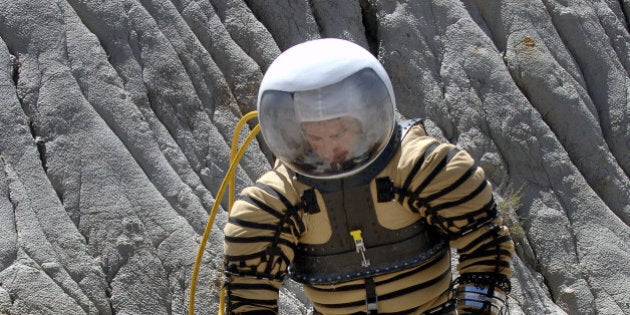
Last weekend, The Martian opened in theatres to rave reviews, a 94 per cent rating on Rotten Tomatoes and an industry-leading $55 million box office. It's THE fall blockbuster of 2015 so far. At first glance it seems like just another Ridley Scott action movie, but might it also be the future of Innovation?
If you haven't yet seen the movie, try to keep a dry eye while you watch this three-minute trailer.
Sure it stars hunky Matt Damon but it's not his physique celebrated here -- it's his brain; specifically, his technical smarts. When the only way to survive is to "science the shit out of this," he steps up. I won't spoil the story for those that haven't seen it, but suffice it to say being both a botanist and a mechanical engineer can come in quite handy.
Damon and a stellar cast of men AND women headline the movie, but science is definitely a notable co-star. In fact, science is downright cool here.
It's certainly not the first movie where science and technology are celebrated -- the 2008 blockbuster Iron Man and its sequels also highlight the trend with the Tony Stark character being the modern incarnation of 1980's TV character MacGyver. Imprisoned in a cave by terrorists? No problem... just build a superhero suit out of old junk that you find lying around.
And just in case you think the trend only applies to a couple of movies, you should know that MacGyver is coming back to TV. Those CBS people know a good thing when they see it!
So, why is The Martian important to the future of innovation?
Because innovation requires two things: It needs a culture of entrepreneurship (or intrapreneurship), and this culture needs to be enabled by employees with the skills required to execute on those entrepreneurial ideas.
It turns out that there's a big overlap between innovation skills and the science capabilities celebrated in this movie.
We have known for some time that an education in science, technology, engineering or math (STEM) fields is as close as our kids can get to a guarantee of a great job; as parents and educators we've made this pretty clear to our kids. Unfortunately that advice hasn't translated into students' choosing a STEM education.
Why? There are many answers.
At a baseline level it's fair to say that courses in these fields are difficult and it's not surprising that, when given the option, they often chose the easier alternative. We told our kids to "get a degree" but we were often not very specific about which degree.
It's also fair to say that STEM education hasn't always been engaging. In fact, we were often guilty of making it downright boring.
And finally, it's one thing for a parent or teacher to nag you about doing your math homework, but when popular culture is flooded with images from reality television, perhaps the most STEM-friendly role models weren't influencing our kids.
If Paris Hilton, Chef Gordon Ramsay or the Kardashians didn't need to learn math, then why should they?
That's why entertainment that celebrates science is such a great thing! It makes science something that kids will aspire to -- it makes science cool!
Of course a nudge from Hollywood isn't the only thing required to further innovation but most other enablers are in place already -- or coming fast.
Technology is increasingly fun to learn about or just plain play with. A generation that grew up with smartphones and video games are now using those same skills to race quadracopters in real world or operate robots in the office.
Additionally, people are adopting the "do it yourself" credo of the maker movement to use 3D printers to make their own Lego bricks. Then they turn around and use those Lego bricks to make their own printers. The possibilities are endless.
Finally, society is increasingly excelling at empowering people of all ages with the basics of entrepreneurship. Traditional academic institutions certainly have a role but incubators and accelerators have such as MaRS, Communitech and DMZ in Canada or Y Combinator, Techstars and Angelpad in the U.S. are also delivering the entrepreneurship education that enables innovation. Interestingly, these programs are oversubscribed by what may be the most entrepreneurial generation in history!
So there you have it. The culture of innovation is here and the underlying technologies are available and actually interesting and fun to use. All we needed was popular culture to provide a gentle nudge so that our students are educated in the STEM jobs of the future.
Go see The Martian soon and when the credits roll, reflect on whether science is just a little cooler than it used to be. The future of our economy may count on it.
MORE ON HUFFPOST:
